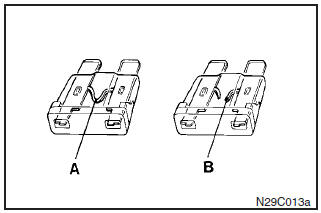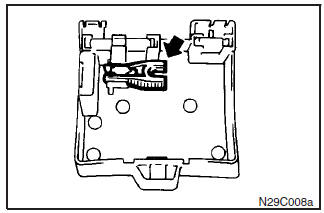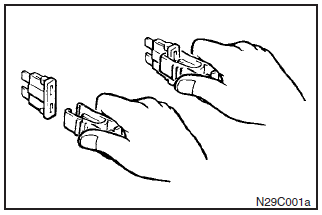Changing a fuse

1. Before replacing a fuse, always turn off the electrical circuit concerned
and turn the ignition key to the “LOCK” position.
2. Remove the fuse box cover.
3. Referring to the fuse load capacity table, check the fuse pertaining to the problem.
A - Fuse is OK
B - Blown fuse

4. There is a fuse removing tool in the fuse cover of the passenger compartement. First take the fuse removing tool out of the fuse cover slowly and then by using the fuse removing tool, pull the fuse straight out from the fuse box. If it is not blown, something else must be causing the problem; contact an authorized MITSUBISHI dealer to have the problem checked.

5. Insert a new fuse of the same capacity into the clip and insert the fuse at the same place in the fuse box.
CAUTION
(1) If the newly inserted fuse blows again after a short time, have the
electrical system checked and repaired by an authorized MITSUBISHI dealer to find
the cause and rectify it.
(2) Never use a fuse with a capacity larger than that
specified or any substitute, such as wire, foil, etc.; doing so will cause the circuit
wiring to heat up and could cause fire.
See also:
Function setting screen
The “Display language”, “Temperature unit”, “Fuel consumption unit”, and “Average
fuel consumption and speed reset method” etc. settings can be modified as desired.
Refer to “Ch ...
Voice recognition function
The Bluetooth® 2.0 interface is equipped with a voice recognition function.
Simply say voice commands and you can perform various operations and make or
receive hands-free calls.
With the Bluetoo ...
Deployment of front air bags
The front air bags ARE DESIGNED TO DEPLOY when...
The front air bags are designed to deploy when the vehicle suffers a moderate
to severe frontal impact. Typical conditions are shown in the illus ...
